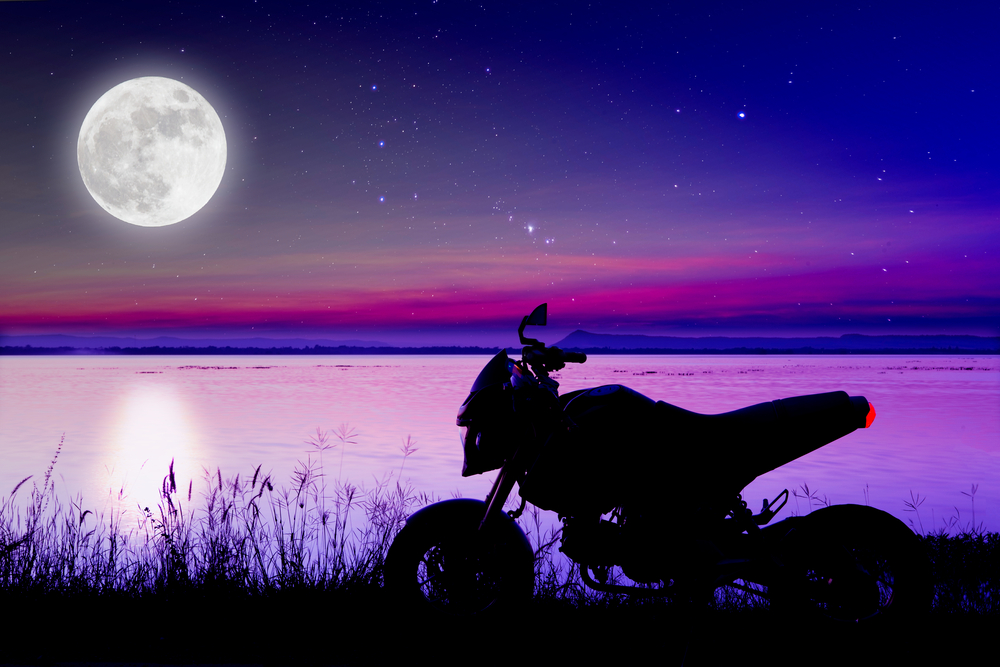Full Moon Is Bad, But Supermoon Is Even Worse for Motorcyclists

The bright light of a full moon or supermoon may seem inviting to motorcyclists eager for a nighttime ride, but that moonlit trip may also come with deadly consequences, a new study finds.
According to data on nighttime motorcycle crashes in the United States from 1975 to 2014, motorcyclists were more likely to die in crashes on nights with full moons. Riders were even more likely to die on nights with supermoons than they were in the weeks before and after the celestial events, researchers found.
"Our study suggests that extra care is needed when riding a motorcycle under a full moon," said lead study author Dr. Donald Redelmeier, a professor of medicine at the University of Toronto, in Canada. [Hyperloop, Jetpacks & More: 9 Futuristic Transit Ideas]
The study was published online today (Dec. 11) in the Christmas issue of the journal The BMJ. The holiday issue is a tongue-in-cheek edition of the medical journal, which normally publishes serious research.
Nearly 5,000 people in the United States die in motorcycle crashes every year. That means that for every seven road traffic deaths, one is motorcycle related, Redelmeier said. "The average ride on a motorcycle is more dangerous than a drunk driver with no seatbelt traveling the same distance," Redelmeier told Live Science.
However, it's difficult to measure distractions that lead to fatal motorcycle accidents. Even motorcyclists who survive accidents usually don't remember what happened immediately leading up the accident, Redelmeier said.
But full moons and supermoons are measureable variables that could distract motorcyclists; they're big and lustrous, especially supermoons, which can be up to 30 percent brighter than regular full moons.
Sign up for the Live Science daily newsletter now
Get the world’s most fascinating discoveries delivered straight to your inbox.
To investigate, the scientists combed through data from the U.S. National Highway Traffic Safety Administration and found all of the motorcycle fatalities occurring from 4 p.m. to 8 a.m. local time over a period of 40 years. This data set included 494 full moons and 65 supermoons.
As a control, the researchers compared motorcycle fatalities on full-moon and supermoon nights to those on the nights one week before and one week after each full moon, Redelmeier said.
Over the moon
In all, about 13,000 people died in motorcycle crashes during the 494 full moon nights and 988 control nights. On average, these motorcyclists tended to be about 32 years old, male, riding in a rural area, not wearing a helmet and involved in a head-on frontal collision.
Calculations show that 9.1 motorcyclists died on nights with full moons, compared with 8.6 motorcyclists who died on nights without full moons. This 5 percent increase amounted to 226 additional fatal crashes on full moon nights over the study period, indicating that for every two full-moon nights, there was one additional fatal accident, the researchers found.
The relative risk was even greater for supermoon nights. A total of 703 fatal crashes happened on these nights, amounting to 10.8 motorcycle fatalities per night, or two additional deaths on supermoon nights compared to control nights. This is about a 22 percent increased relative risk compared to control nights.
The researchers also studied motorcycle crash data in the United Kingdom, Australia and Canada, finding similar trends in those locations.
However, because the study is observational, it has several limitations. The researchers didn't check the weather, the price of gasoline, or whether it was the motorcyclist or another driver who was at fault for the accident, according to the study.Moreover, the study doesn't show cause and effect, but rather that full moons are associated with increased motorcycle fatalities, Redelmeier said. [Photos: The Robotic Evolution of Self-Driving Cars]
Even so, the research sends an important message that distractions, even seemingly benign ones such as a full or supermoon, can be deadly for motorcyclists, the researchers said. Motorcyclists can take a few steps to stay safer, the study said.
"Additional strategies while riding might include wearing a helmet, activating headlights, scanning the road surface for defects, respecting the weather, being wary of left-turning vehicles, obeying traffic laws and forgoing stunts," Redelmeier and study co-author, Eldar Shafir, a professor of behavioral science and public policy at Princeton University, wrote in the study.
Original article on Live Science.

Laura is the archaeology and Life's Little Mysteries editor at Live Science. She also reports on general science, including paleontology. Her work has appeared in The New York Times, Scholastic, Popular Science and Spectrum, a site on autism research. She has won multiple awards from the Society of Professional Journalists and the Washington Newspaper Publishers Association for her reporting at a weekly newspaper near Seattle. Laura holds a bachelor's degree in English literature and psychology from Washington University in St. Louis and a master's degree in science writing from NYU.










